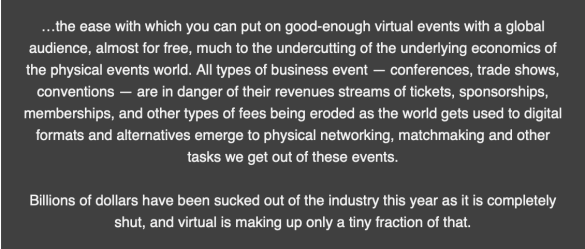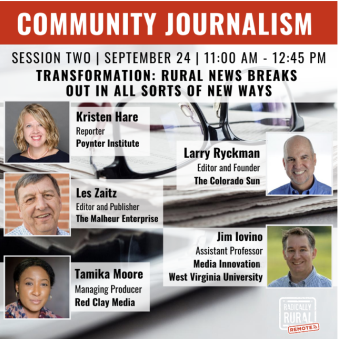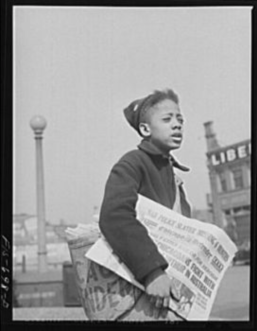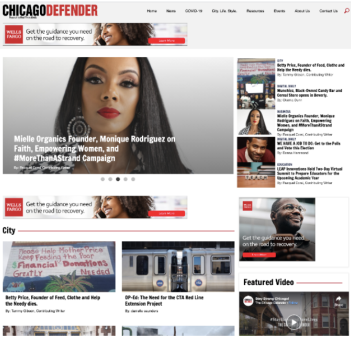
Our New Virtual Reality
Sept. 3, 2020
One thing we at NewStart preach to our students (and to the industry at large) is the need for media outlets to diversify their revenue sources.
A bright spot in that department the last couple of years has been the hosting of live events.
Annnnd … then the pandemic happened.
The topic of events still comes up often, but now it is in a different context: how can we transition our in-person events to a virtual environment and still make money? And what do those events even look like?
These are questions that many industries are grappling with, so it’s not unique to media outlets.
In an excellent article on Skift, Rafat Ali says “Zoom is the Napster of the event industry.” And anyone who was online back in the Napster days knows that’s not a good thing for those trying to make money. (Personally I was a Winamp guy who perused tons of music blogs that offered up free mp3s, but that’s a story for another day…)
But what does Ali mean with the Napster comparison?

Yikes.
Ali estimated that for Skift events, “in the best case scenario, virtual one-day events bring in only about a quarter to a third of what a physical conference revenues used to pre-pandemic.”
Double yikes.
So where does that leave us? Well, I’d say that leaves us in an opportunity zone, where those who are able to take advantage of the existing technology can survive and thrive, and those who innovate beyond that have a chance to be leaders in this space.
Jacqui Park, a JSK fellow at Stanford, wrote about the next wave of virtual events building off of whatever we’ve been able to scrape together on Zoom the past couple of months.
Park brought up eight takeaways for future virtual events, “all based on the one big idea that each new medium, each new distribution channel, teaches us: the medium is the message!” You can read about those eight takeaways here.
That brings us to the focus of today’s newsletter: Terry Williams, the president and COO of The Keene Sentinel in New Hampshire. He’s not here to tell you he’s developed a new virtual event technology, but he’s trying to envision what an outstanding in-person event that revolves around all things rural can look and feel like when it’s moved online.
Williams currently is developing the Radically Rural conference, which will take place Sept. 24. When life was good, the conference was held in a scenic New Hampshire town. This year you can participate from wherever your internet connection takes you via a virtual venue called Hopin.
Radically Rural focuses on issues and opportunities in small cities and towns across the country, with a particular focus on six areas: main streets, entrepreneurship, community journalism, arts and culture, land and communities, and clean energy.
(Full disclosure: I will be a panelist for one of the community journalism sessions. Despite that fact, this event looks fantastic and you may want to register and attend.)

Instead of Radically Rural being held in numerous quaint locations throughout Keene, it has moved online.
“When COVID hit us, that was in the March timeframe, and with this being a September event, we had to figure out if this was going to be a serious problem or something that might subside and we could still have the event,” Williams said. “It became pretty clear that as the rate of infection increased, it made no sense to do this in person.”
So in April the decision was made to go virtual. Soon after it was decided to make it an event experience instead of a webinar. Soon after that, Hopin was chosen as the virtual venue because it had some networking components to it that Zoom and other platforms don’t offer.
As with any change like this, Williams said there are advantages and disadvantages in transitioning to a virtual event.
For one thing, being virtual expands the potential audience, as a lot of people may not have been able to afford the travel costs of getting to the event and, as Williams admits, it’s not easy to get to Keene. Having a virtual component was something Williams and his team already were considering adding down the road. The pandemic made it a reality this year.
A virtual environment also means you don’t have to spend money on venues, food, drink, speaker travel costs and, worst of all, my very own outlandish demands, including a well-armed security detail, five bottles of Pappy Van Winkle and a baby panda.
Don’t ask.
At the same time, however, one of Radically Rural’s most popular features in previous years was the Connect event, where everyone eats, drinks and networks like nobody’s business. That ambiance is gone. And Williams said it is hard to transition sponsors of those types of events to other virtual opportunities.
“There are significant costs associated with that event … but we lost a lot of sponsorship associated with that event, too,” Williams said. “So it’s a bit of a wash.”
And while the physical venue costs are non-existent, the Radically Rural team had to factor in other costs for things like the virtual venue platform and tech support to make sure it works as planned.
Williams and his team have hosted several other virtual events this year, including awards shows, so they have a good sense for what’s in store for them in a few weeks. And Williams already knows what he’s going to miss most — the live audience.
“These (events) can be done, for sure,” he said, “but it is disappointing not having a live audience there to push you along or give appreciation to award winners and those things.”







